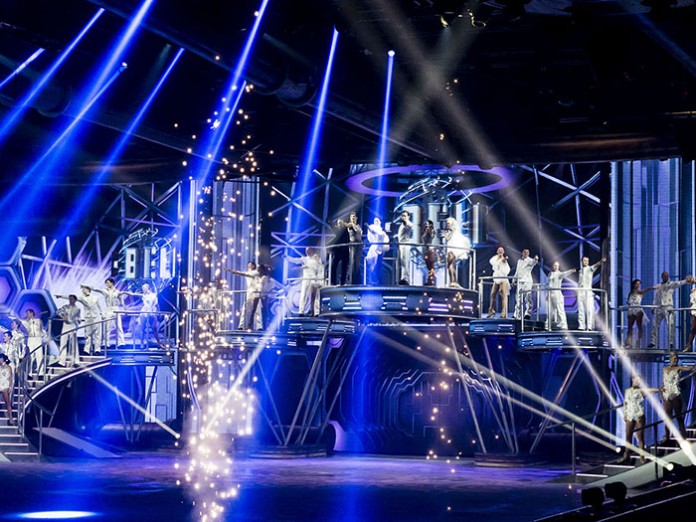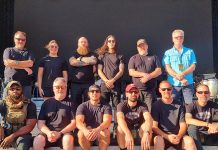WIcreations delivered a custom automation solution for the brand new Holiday on Ice show BELIEVE, as well as fabricating the elaborate set as an efficient touring package.
The world premiere of the new ice dance spectacle took place in Grefath, Germany and continued touring in Europe.
Hans Willems led the WI team for this project, working directly for producers Netherlands based Stage Entertainment, and closely with set and Scenic Designer Luc Peumans from Painting with Light.
Willems and WI have worked on many previous Stage Entertainment productions including ‘Ice Age Live‘. In fact, WI’s association with Stage Entertainment started in 2006 on the HOI ‘Mystery‘ show of that year – the same year that WIcreations was founded.
Willems commented, “HOI is an important part of our company history and it was fantastic to be working on another ambitious and radical production, to meet all the challenges and collaborate with many talented and dedicated individuals all sharing the same goal to ensure a smooth, slick and streamlined production that will be enjoyed by audiences worldwide.”
The story was a new version of Romeo & Juliet – living in two separate worlds, the Underworld and the Upperworld. This required a dynamic and contrast rich approach with a lot of motion and numerous different levels to shape the story. The show was directed and choreographed by Olympic skating champion, Christopher Dean.
The intricate ‘stage’ comprised a series of interconnecting curved platforms, walkways and sweeping staircases – most of them clad with LED video panels – and this filled the space along one end of the ice.
It involved two prominent eight metre high elevators with curved LED doors at the top, which were used extensively throughout the performance for entrances and exits.
The video doors at the top of the elevator were attached to tracks in the roof that were integral to the elevator structure and dealt with the open / closing movement, while the positional movement cues for the LED doors were linked to the Pandora’s Box media server playing back the video, so exactly the right element of video footage appeared on the visible portion of the doors as they move.
The elevator platforms were moved up and down via a system based on one of WI’s most popular multipurpose standard products, the WI Stacking Truss. The elevators themselves had been custom constructed for this show but were based on more standard WI products.
The vari-speed hoists controlling the elevator platform movement were running on Kinesys Vector control on the same networked system as the tracks moving the curved video doors. The lifts were used constantly throughout the show for performers to access set platforms at several different levels.
On top of the central set platform was a DJ booth, which also tracked 30 metres to the centre of the ice using a WI Track touring system driven by two vari-speed double-channelled hoists attached to the track.
When in its ‘home’ position in the middle of the set, this DJ platform had two skate ramps either side that gave access down to the ice.
The DJ booth was also built at WIcreations’ HQ in Heist-Op-Den-Berg and fitted with all its LED screen. Because it was designed using WI Stacking Truss, the rigging and hoists combined remained under one tonne in weight, which was crucial for tracking as most venues offer a good selection of one tonne pointes, but if it exceeds that, the whole process becomes a lot more complicated.
WI also supplied a SIL3 zero speed motor attached to the same track, which was used to lift two performers during the Bolero routine.
WI also contracted four 3.2 diameter scenic fan structures, which were flown above the ice, three to provide overhead lighting positions, and the fourth contains a circular water screen which was activated for a special effect sequence in the show.
Another challenge was designing all the various set elements so they pack down into a series of dollies for neat and practical transportation. LED screens are designed, where possible, to travel with most of the relevant set pieces, rather than being attached separately at each venue and lighting fixtures – supplied by Focus Showlighting – were also built into some parts of the set.
Painting with Light’s Peumans imagined the set working alongside his talented team of Paco Mispelters who created the lighting and Michael Al-Far who designed the video. “It was a fantastic opportunity to show what Painting with Light can do as a full live show production resource,” commented Peumans, whose original ideas for the scenic were chosen from a competitive pitch.
The set was 28 metres wide comprising multiple layers, platforms and moving parts including two prominent stage elevators, synthetic ice ramps plus a DJ booth that tracks out over the main ice. Almost all of the set and its peripheries – like the two giant fans and water screen feature over the ice – was clad in curve-able 9.3 millimetre LED video panels supplied by CT.
Using video as digital scenery enabled the mood and action to change dynamically and instantaneously throughout the set, a hypothesis that was at the essence of Peumans’ production design. The visual imagery and ambience of the upper and lower worlds was created graphically and in great detail to enhance the audience experience, and also on a large scale so everyone could benefit, wherever they were sitting in the venue.
“Video coupled with some classic theatrical scenic elements was the only option to achieve the level of detail required and that allowed us to flip completely from one world to another at the touch of a button” explained Peumans, whose first drawings dated back to April 2015 after initial meetings with the producers and Dean who wanted to explore the two worlds theme.
At the first meeting Dean walked everyone through the story, scene by scene, and how he envisioned the scenes in terms of lighting, video and sound. His very clear vision and ability to communicate that so lucidly to the Painting with Light team ensured a smooth work process could evolve. The lower world was dark, threatening, raw and mechanical, whereas the upper world was light and filled with glitter and glamour. Above the set, snaking around the roof was a network of inflatable scenic tubes – made by Airworks – which made up pipes for the underworld scenes, adding to the overall proto-industrial feel and extending the set 46 metres over the ice.
Also flown above the ice were three giant three metre wide fans housed in LED illuminated surrounds compete with eight inbuilt Martin Rush Beams for effects and video surface on the under-belly and sides – which were filled with elaborate graphics. One of these scenic fans piece was fitted with a circular water curtain from Unlimited FX, complete with integral LEDs that were specified by Painting with Light, which looks fabulous highlighting the bursting and cascading water for a pole dancing sequence inside the ‘cage’.
Mispelters’ starting point for the lighting design was the set, the story of the two worlds and the need to work closely with the video content. He constructed the cues according to the storyboard using around 150 moving lights, mostly Martin, delivered by Focus Holland and positioned on a network of trusses installed in the roof of each gig. Fixtures included MAC Quantum Spot LED luminaires which he was very happy with, plus MAC 700 Washes and MAC Aura LED washes for the floor and side lighting. Some MAC Auras are also built into the set – fabricated by WIcreations – at the top of the stage elevators and these light performers standing on the various platforms.
Substantial amounts of LED PARs were dotted around and utilised to light the platforms and the set elements that were not covered in video. Mispelters also added plenty of atmospherics including Chauvet Geyser vertical smoke jets, which created a CO2 effect, and Le Maitre Spraymaster non-propane DMX controlled fire shooters, all running into the grandMA2 console together with all the lighting. For continuity of lightsource, Martin MAC 3 Profiles were chosen as the five follow spots, with handles mounted on the fixture and the operator in control of the dimmer and iris functions with all the colour and on/off cues coming from the grandMA 2, which was programmed by Arjan Grootenhuis.
Moving and still images were a vital part of the show narrative and of imagining the different worlds, and the physical design included approximately 220 square metres of the 9.3 mm CTG9 bendable panels – chosen for their amazing flexibility and robust finish. Al-Far spent around five months creating the content, a process that involved commissioning a concept artist to sketch out the two worlds according to the brief and mood-board, after which the content production process became fully energised.
A 3D modeller then translated the 2D sketches into 3D using Cinema 4D and as the scenes started to take shape, Al-Far started texturing and lighting the material. They arrived at the production rehearsals in Utrecht, where content was animated, rendered, assembled and finalised on the timeline over several weeks. The biggest challenge was finding the balance between what was in their heads and what actually worked on the gigantic LED wall Al-Far explained.
His favourite moment of the show was when female principal Clarissa enters the underworld, arrived in the Forbidden City. Until then, the underworld was universally grim and dingy, but as that barrier was breached it opened the opportunity of lighting this foreboding mechanical world completely differently. “We added some silhouetted butterflies and magenta and purple floral aspects giving me the great satisfaction of seeing this world thrive under a more up-beat colour palette,” enthused Al-Far.
All the edited materials were stored and programmed by Painting with Light’s Katleen Selleslagh in a Conlux Pandora’s dual media server supplied to the production by Painting with Light, together with a wireless player with DMX link in the DJ booth. The show was triggered via SMPTE timecode and now it’s on the road, is effectively ‘plug-and-play’ for the operating crew.
“One of the great strengths of Painting with Light is that we all know one another really well, so the creative dialogue between all the visual mediums comes extremely naturally and is a fertile and productive process with a great flow and understanding,” commented Peumans.
Dean complimented Peumans on being able to get inside his head and make his vision come to life, adding that he was ”honoured” to have been able to work with Peumans and the team and stated that he hopes their paths will cross again soon.






